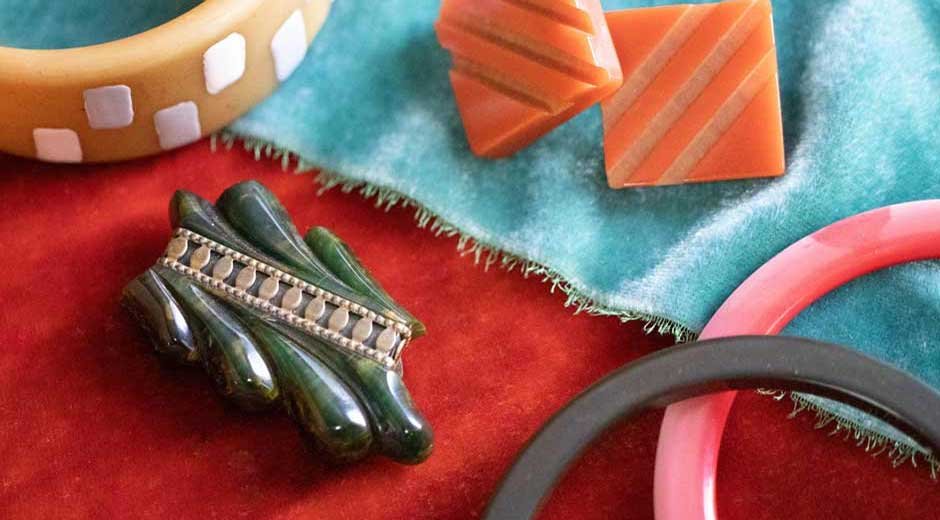Collectors feel an affinity specifically with bakelite jewelry. The history of the object itself and its aesthetic value have made it one of the most desirable items. At the same time, contemporary plastics have transformed and expanded design through their flexibility and low cost. Understanding different types of these materials can help the collector decide where to put his money.
The Origins of Bakelite Jewelry
Bakelite was one of the first synthetic plastics developed in the 20th century. It was invented by a Belgian chemist and quickly became a popular material thanks to its versatility and strength. With the extensive use of vivid colors and patterns in jewelry in the 1930s and 1940s, Bakelite gained a lot of popularity.
Bakelite jewelry is valuable to collectors due to its history. Every piece has a history of innovation and creativity from yesteryear. Bakelite’s appeal is in its weight, feel, and unique sound when you gently flick it with your finger.
Characteristics of Bakelite
Bakelite is famous for its strength and thermal resistance. Its natural resistance to melting and burning made it a desirable solution. The color of this first draft varied from dark yellows to dark reds and greens. Worn patina on Bakelite only adds to its vintage. The Bakelite will develop a patina over time.
There are simple tests to confirm Bakelite, which is commonly used among collectors. The Hot Water test involves placing the object under hot water to allow it to release its formaldehyde smell. Another way is the sound test, since when we tap, it makes a special clunk sound.
Modern Plastics in Jewelry
More modern plastics include acrylic and polycarbonate. This material has a wide range of colors and finishes. It is light and flexible, allowing designers to play with big shapes and sizes.
Modern-day plastics may not be as charged with history as Bakelite, but they can offer an infinite scope for imaginative use. They are inexpensive and readily available, which makes them accessible to a broader audience.
Comparing Aesthetics and Value
Bakelite jewelry has become famous for its deep, bold colors and detailed carving. It is also generally unique, and some pieces are handcrafted and, therefore, very precious. The imperfections and tiny differences between Bakelite pieces are part of the charm for collectors.
Modern plastics, by comparison, are consistent and precise. Yes, obviously, this enables mass production of them, which may decrease their value a bit. But modern designs can be cool-looking as well if you like things a little more streamlined and less traditional.
Considering Sustainability
Sustainability has also emerged as an essential variable for many collectors. Being a thermosetting plastic, Bakelite is also non-biodegradable. However, durability allows for generations of pieces when cared for properly. Since collecting vintage Bakelite supports Biodegradable and Recyclable, it gives Bakelite a Second Life and thus fulfills Sustainability as a whole, and acts through its activities as a soft power to achieve these goals, per se.
Today’s plastics have different effects on the environment. Certain types can be recycled, while others are sent to landfills. Being aware of these considerations can help collectors choose environmentally friendly options.
Price and Investment Potential
Bakelite jewelry can be more expensive because it is older and rarer. Bakelite was one of the most prominent players in those times, and the market has been booked for Bakelite pieces since its decline; some collectors have even expanded its color specification. Bakelite is a good investment because its lack of availability will always increase its Value.
Modern plastic jewelry is affordable. Though not the same regarding investment prospects, it allows collectors to dip their toes into contemporary without a hefty price tag.
Preservation and Care
Bakelite requires more detailed care. To protect its color and integrity, it must be kept away from direct sunlight and harsh chemicals. However, to retain its shine and luster, it only needs regular wiping with a soft cloth.
While modern plastics are generally easier to maintain, they can scratch and fade over time. Keeping them cool and dry should help preserve their appearance.
Conclusion
Collectors have a lot to ponder when deciding between Bakelite jewelry and modern plastics. Amid the historical warmth of Bakelite and the modern innovations of working with plastics, each offers particular advantages. Appreciating these differences can go a long way in helping collectors make informed decisions that suit their aesthetics and philosophies. From the sensual nostalgia of Bakelite to the whimsy of modern pieces, each of these examples of jewelry is highly collectible in its own right.






